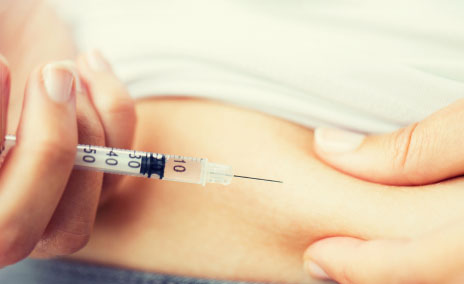Injections Procedure
Whether you require ongoing treatment, vaccination, assistance with administering injections for medications prescribed by doctor/s, or simply seek improved education on doctor-prescribed self-injection, Jaga-Me is here to provide the assistance you need. Our team of doctors and nurses is equipped to administer injections or training within the comfort of your home, tailored to your needs.


What is an Injection?

An injection is a medical procedure that involves the introduction of medication or substances into the body using a needle and syringe. This method ensures that medications are delivered precisely where they are needed, providing rapid and effective results.
Injections are commonly used for various purposes, including administering medications, vaccinations, and managing specific medical conditions.
Types of Injections
Intramuscular Injection (IM)
An Intramuscular Injection (IM) delivers medication directly into large muscle groups such as the upper arm, thigh, or buttocks. This method ensures rapid absorption into the bloodstream and is suitable for medications requiring fast or higher-volume absorption.
Examples of medications via IM delivery are vaccinations, medication to treat giddiness or vomiting.
Subcutaneous Injection (SC)
A Subcutaneous Injection (SC) delivers medication just beneath the skin, using a shorter and thinner needle than IM injections. This method is suitable for medications requiring gradual absorption, like insulin for diabetes management. Common injection sites include the abdomen, thighs, and upper arms.
Jaga-Me Injection at Home
Jaga-Me offers the convenience of injection procedures at your doorstep. Our team of healthcare professionals is prepared to administer these procedures in your home, addressing a wide range of medical conditions.
Benefits of Having Your Home Injection Procedure Done at Home
Personalized Care
Our professionals provide you with individualized attention, ensuring treatments are tailored to your needs.
Reduced Travel
Eliminate the need for commuting to medical facilities, saving you time and effort.
Minimized Stress
Your familiar home surroundings reduce anxiety often associated with medical settings.
Family Support
Your loved ones can be present to offer emotional support during your Injection Procedure.
Lower Infection Risk
Minimize your exposure to hospital-acquired infections in your home environment.
Common Reasons for Injection Procedures
Intramuscular Injection (IM)
Vaccination
Crucial for preventing infectious diseases, IM injections deliver vaccines into larger muscles like the arm or thigh, promoting efficient absorption. This stimulates immunity against targeted diseases.
Hormonal Agents
Certain hormonal therapies e.g. testosterone replacement for patients with hypogonadism can be given via the IM method. Such injections are very convenient as compared to daily oral pills or patches. The latest injectable testosterone preparations require only one injection every three months. The absorption rate is constant and there are no added actions or medications that patient need to do or take between the injections.
Medications for symptoms management of acute illness
As such injection ensure that the treatment enters the body, medications e.g. to stop vomiting or giddiness administered this way would help when the patient is unable to take in the medication through the oral way.In serious allergic reaction i.e. anaphylaxis, medications given IM are necessary to reverse or halt the symptoms e.g. rashes, low blood pressure or wheezing.
Subcutaneous Injection (SC)
Insulin Injections
Subcutaneous insulin injections regulate blood sugar in diabetes. Administered in fatty tissue, they mimic natural insulin release, aiding glucose control.
Erythropoietin injections
Erythropoietin (EPO) is a growth factor produced in the kidneys that stimulates the production of red blood cells. In some patients with anemia, regular SC EPO injections are prescribed by doctors to help boost the bone marrow production of red blood cells, to minimise the need for blood transfusions.
Blood thinners
Enoxaparin belongs to a group of medications known as anticoagulants. It may be used to prevent existing clots from worsening, or to prevent clots from forming due to acute illness or prolonged immobilisation. It is given for patients with blood clot(s) in the leg(s) / lung / heart / others, or recent major surgery which requires prolonged immobilization to prevent blood clots in the leg(s)
Palliative care
Subcutaneous administration of medication/s is common practice in palliative care to manage pain and other distressing symptoms when other routes are inappropriate or ineffective e.g. patient is too drowsy to take orally. Either given on a when necessary per injection basis or using power-driven devices a.k.a. pumps to deliver medications at a controlled rate to provide symptom control, subcutaneous route of administration of medications for symptom control is an important part of care to ensure comfort for many patients at their end of life.
Cancer treatment
SC injections beneath the skin deliver chemotherapy drugs gradually into the bloodstream, enhancing cancer treatment effectiveness while minimizing side effects. A good example is Herceptin Hylecta which is a combination of trastuzumab, a HER2/neu receptor antagonist, and hyaluronidase, an endoglycosidase, for the treatment of HER2overexpressing breast cancer and is given via the SC method.